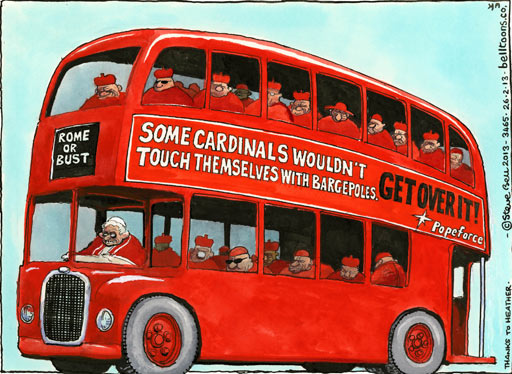The Vatican has been reining in the progressive leadership of American nuns, creating a political test of wills over the future of a faith with one billion adherents worldwide as it braces for an historic papal transition. Described as a modern ‘Inquisition,’ this punitive campaign against the nuns lands on the 50th anniversary of the Second Vatican Council and raises fundamental questions about the mission of a global church and the role of nuns who were inspired by Vatican II in taking the social justice gospel directly to the world’s poor.Vatican's looming 'Inquisition' reveals a fractured Catholic ChurchAs Pope Benedict XVI steps down and briefly leaves an empty seat, a conflict over spiritual mission and real estate will pause to await the next pope.
Costa, Calif.
“Dan Ward was my mentor at St. John’s in Collegeville [Minnesota] in the 1980s,” explains Wall. “He taught me everything I know.”
In the late 1990s Wall, who was mentored by Ward in the seminary in the 1980s, grew disillusioned after serving at five consecutive Minnesota parishes, cleaning up after priests who abused youths or diverted parish funds to personal use. Wall left the priesthood, moved west and since 2002 has worked as a researcher and expert witness for lawyers representing clergy abuse victims. That role has occasionally put him across the table from Ward in his defense work for clergy perpetrators. Wall, married with a daughter in grade-school, accepts the reversal of roles with Ward as a professional matter. Like the nuns at Holy Wisdom, he moved beyond the church, becoming, in turn, an Episcopalian, then a Methodist, and a Buddhist. But the church he left still permeates his life.
“When you look at the larger crisis,” continues Wall, “you ask yourself: Why go after the nuns when they’re a dying group, in terms of numbers, yet these women have been more faithful to church than the clerics have? It makes no sense. But that’s where Dan Ward has been righteous — he is extremely well-read with a work ethic that will run you over. The only reason you go after the nuns is because a bishop wants to know where that property is going.”
When the Benedictine Sisters fazed out of existence, they did so without giving the bishop of Madison the opportunity to take title to their property and grounds. Ward orchestrated their end run. Ward also assisted nuns in Sacramento, Calif., in the selling of a school that sparked a huge controversy, according to a spokesman for Bishop Jaime Soto.
A RECYCLED CITY ON THE HILL
Many sisters interviewed for this report suspect — though none can prove — that Madison Bishop Robert Morlino protested to the Vatican about Ward’s role. That they say would explain why the Doctrinal Assessment singled out his group, Resource Center for Religious Institute, for its association with the LCWR.
At the Diocese of Madison, spokesman Brent King responded to an email asking if Morlino had reported Ward’s work to Rome.
He said, “The Diocese of Madison has said everything it plans to say publicly at this time with regards to Holy Wisdom Monastery. We would have no public comment about Fr. Dan Ward.”
What Morlino has said, in warning Catholics about Holy Wisdom Monastery, is relatively mild. He accused the community of “indifferentism...the belief that not one religion or philosophy is superior to another.”
He said that the Holy Wisdom community “may not share an authentic view of the Catholic Church’s approach to inter-religious dialogue.”
But the bishop has no real power over the group.
In moving out of a Romanist idea of church, as many nuns had already done in taking a social gospel to the poor, and quietly moving leftward in their social and theological positions, the Wisconsin community followed their own vision and remade the place into their own idea of a spiritual city on the hill.
They oversaw the dismantling of the Benedict House with care so that 97 percent of its parts were responsibly recycled.
In 2009 the construction was done on a 30,000-square-foot Holy Wisdom Monastery. It has cutting-edge design as a green complex, utilizing solar energy, geothermal pumps, large energy-absorbing windows, roof gardens and storage tanks to recycle rain.
Bishop Morlino watched from the sidelines as the liturgies went well beyond the traditional Mass.
Today, women lead services and preach. Gay people in committed relationships are welcomed. Anyone at services, not just Catholics, can receive communion, in contrast with the Catholic prohibition on priests giving the Eucharist to non-Catholics.
ANOTHER TARGET OF THE ‘INQUISITION’
The investigation by the Congregation of the Doctrine of the Faith in 2012 took special aim at Sister Laurie Brink. Specifically, the so-called “Doctrinal Assessment” focused on a 2007 speech at an LCWR conference, which referred to some communities as “moving beyond the church,” a characterization that would apply to Holy Wisdom.
Brink is a member of Dominican Sisters of Sinsinawa, a Wisconsin community pledged “through the ministry of preaching and teaching...to participate in the building of a holy and just church and society.”
The Sinsinawa Dominicans are in the liberal mainstream of American nuns, a current that the April 2012 Doctrinal Assessment tried to halt, if not divert. The congregation has 500 members with missionaries in several foreign countries. The headquarters at Sinsinawa Mound, once a famous Indian site, covers 800 acres with a large motherhouse, chapel and retreat complex. A girls’ school that closed several years ago has been converted to housing for the elderly.
Cardinal Levada called Brink’s August 2, 2007 speech to an LCWR gathering “a serious source of scandal...incompatible with religious life.”
Brink’s speech enraged Levada as it provided one image after another in a verbal carousel of today’s church as deeply polarized and supportive of progressive initiatives that were threatening to hierarchs like Levada and Law. She offered sharp criticism of church leaders, who too often recycled pedophiles from one parish to the next. Without mentioning bishops by name, Brink confronts a church of inner strife. And then speaking directly to the graying mother superiors, many disappointed by a road from Vatican II to latter day betrayal by the Vatican, she tells them to think of how “to become ambassadors of Christ, initiating reconciliation.”
“Reconciliation first with our hierarchical church from which we have experienced abuse, oppression, neglect and domination. If there is to be a future for women religious that upholds our dignity...we must first be reconciled with the institutional church,” she said.
* * *
“This is not about faith — it’s about politics,” says Sister Simone Cambell of Network, the Washington, D.C. social action agency also singled out in Levada’s assessment. “All of our work as Catholic sisters is engaged with the world and that is different from living in Vatican City where that’s your only world. “The rules make a protective wall. Most Catholic sisters see engagement as way of living the gospel.”
RCRI, the group led by Father Ward, helped Network secure autonomy for property it owns, says Campbell.
Network and the Catholic Health Association supported ‘Obamacare’ as helping the poor get insurance; the bishops attacked the legislation as favoring abortion and forcing coverage of contraception. Campbell, who became an overnight sensation after speaking at the Democratic Convention, says Network labored in obscurity for years until the health care debate raised the bishops’ ire.
“What we saw with Nuns on the Bus is a huge hunger for a deeper spiritual reality that does like Jesus does, walk with people who are suffering,” says Campbell.
Over the last two decades, as the bishops sank into a quagmire of clergy abuse cases, the nuns maintained and perhaps even intensified their focus on a social justice mission all over the world.
Sisters like Pat Farrell returned from El Salvador to help immigrants in the Midwest, and as a therapist with people who had been tortured before fleeing Central America. In Cleveland, Chris Schenk worked with parishioners who reversed a bishop’s closure orders for their parishes with appeals to the Vatican. And the Holy Wisdom sisters left the church by staying put, following a more radical, egalitarian idea of the spiritual life. Countless other women of the sister’s liberal mainstream went about their work, following the vision of Vatican II that had changed their lives, and living a resistance to the retrenchment by the hierarchy that sought to reverse the reforms ushered in by Vatican II.
“The bishops sitting in the US have on average only five years of pastoral experience,” says Simone Campbell. “They don’t know what it is to enter into people’s lives in heartbreaking situations. And when your heart hasn’t been broken you can be pretty rigid in thinking rules can’t be broken.”
GlobalPost Vatican correspondent Jason Berry, is author of “Render unto Rome: The Secret Life of Money in the Catholic Church,” which received Investigative Reporters and Editors 2011 Book Award. This Special Report is supported in part by a Knight Grant for Reporting on Religion and American Public Life, sponsored by the Knight Program at the USC Annenberg School for Communication & Journalism; the Pulitzer Center for Crisis Reporting; and the Fund for Investigative Journalism.






